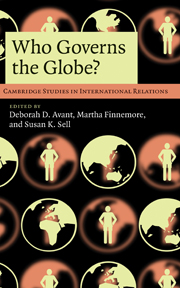Book contents
- Frontmatter
- Contents
- List of figures
- List of tables
- List of contributors
- Preface
- 1 Who governs the globe?
- Part I Authority dynamics and new governors
- Part II Authority dynamics and governance outcomes
- 7 Packing heat: pro-gun groups and the governance of small arms
- 8 Governing the global agenda: “gatekeepers” and “issue adoption” in transnational advocacy networks
- 9 Outsourcing authority: how project contracts transform global governance networks
- 10 When “doing good” does not: the IMF and the Millennium Development Goals
- 11 The power of norms; the norms of power: who governs international electrical and electronic technology?
- 12 “Education for all” and the global governors
- 13 Conclusion: authority, legitimacy, and accountability in global politics
- References
- Index
- Cambridge Studies in International Relations
11 - The power of norms; the norms of power: who governs international electrical and electronic technology?
Published online by Cambridge University Press: 05 June 2012
- Frontmatter
- Contents
- List of figures
- List of tables
- List of contributors
- Preface
- 1 Who governs the globe?
- Part I Authority dynamics and new governors
- Part II Authority dynamics and governance outcomes
- 7 Packing heat: pro-gun groups and the governance of small arms
- 8 Governing the global agenda: “gatekeepers” and “issue adoption” in transnational advocacy networks
- 9 Outsourcing authority: how project contracts transform global governance networks
- 10 When “doing good” does not: the IMF and the Millennium Development Goals
- 11 The power of norms; the norms of power: who governs international electrical and electronic technology?
- 12 “Education for all” and the global governors
- 13 Conclusion: authority, legitimacy, and accountability in global politics
- References
- Index
- Cambridge Studies in International Relations
Summary
Introduction
“Who governs?” Robert Dahl (1961) asked in his classic pluralist study of New Haven politics. This volume takes his question to the international level, asking a series of related questions about the actors in “global governance.” I apply Dahl's deceptively simple core question to the governance of terminology, measures, design, and performance characteristics of electrical and electronic phenomena and products. Electrical and electronic technology is governed internationally through the technical standards of the International Electrotechnical Commission (IEC). In this international nongovernmental organization, as elsewhere, governance involves the exercise of power and hence warrants political analysis.
There are many reasons – at least 5,425 of them, as of the end of 2008 – to concern oneself with IEC standards. Three brief examples will illustrate the point. When I take a picture with a digital camera, I can view the image on the camera's LCD screen or send the image to a printer, almost anywhere in the world. While resolution, clarity, and quality of display and printout might differ by manufacturer and model, the screen and the printer will both recognize and produce essentially the same colored image, even though the LCD screen uses a mix of red, green, and blue light to produce each color whereas the printer uses cyan, magenta, yellow and black ink or dyes.
- Type
- Chapter
- Information
- Who Governs the Globe? , pp. 292 - 332Publisher: Cambridge University PressPrint publication year: 2010
- 12
- Cited by

